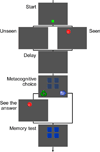Evaluation of seven hypotheses for metamemory performance in rhesus monkeys
- PMID: 25365530
- PMCID: PMC4308511
- DOI: 10.1037/xge0000031
Evaluation of seven hypotheses for metamemory performance in rhesus monkeys
Abstract
Knowing the extent to which nonhumans and humans share mechanisms for metacognition will advance our understanding of cognitive evolution and will improve selection of model systems for biomedical research. Some nonhuman species avoid difficult cognitive tests, seek information when ignorant, or otherwise behave in ways consistent with metacognition. There is agreement that some nonhuman animals "succeed" in these metacognitive tasks, but little consensus about the cognitive mechanisms underlying performance. In one paradigm, rhesus monkeys visually searched for hidden food when ignorant of the location of the food, but acted immediately when knowledgeable. This result has been interpreted as evidence that monkeys introspectively monitored their memory to adaptively control information seeking. However, convincing alternative hypotheses have been advanced that might also account for the adaptive pattern of visual searching. We evaluated seven hypotheses using a computerized task in which monkeys chose either to take memory tests immediately or to see the answer again before proceeding to the test. We found no evidence to support the hypotheses of behavioral cue association, rote response learning, expectancy violation, response competition, generalized search strategy, or postural mediation. In contrast, we repeatedly found evidence to support the memory monitoring hypothesis. Monkeys chose to see the answer when memory was poor, either from natural variation or experimental manipulation. We found limited evidence that monkeys also monitored the fluency of memory access. Overall, the evidence indicates that rhesus monkeys can use memory strength as a discriminative cue for information seeking, consistent with introspective monitoring of explicit memory.
Figures











References
-
- Aron A, Aron E. Statistics for psychology. Upper Saddle River, NJ: Prentice Hall; 1999.
-
- Benjamin AS, Bjork RA. Retrieval fluency as a metacognitive index. In: Reder LM, editor. Implicit memory and metacognition. Mahwah, NJ: Lawrence Erlbaum Associates, Inc.; 1996. pp. 309–338.
Publication types
MeSH terms
Grants and funding
LinkOut - more resources
Full Text Sources
Other Literature Sources

